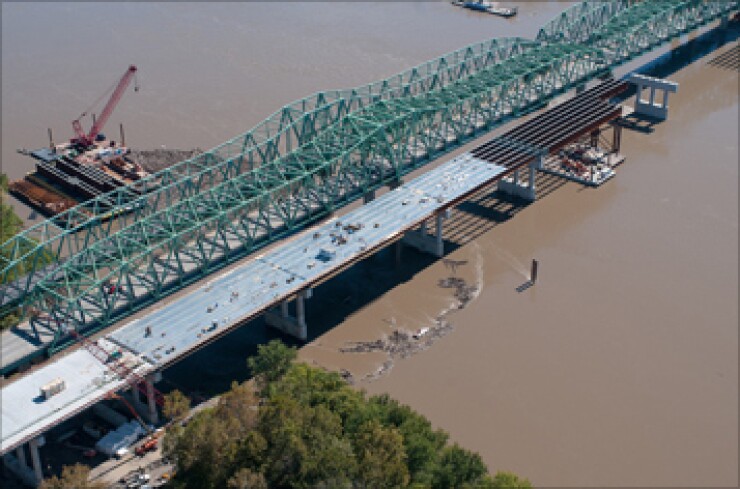
DALLAS – The inadequate national investment in transportation infrastructure means it will take at least 21 years to replace or upgrade the 58,500 structurally deficient road bridges in the U.S., according to the latest bridge inventory from the Federal Highway Administration.
There are 2,574 fewer structurally deficient bridges in the 2015 report than in 2014, but nearly 9.5% of more than 600,000 bridges on the national highway grid fall into that category, the American Road & Transportation Builders Association said in its analysis of the FHWA data.
The FHWA bridge census shows that there were 4,625 structurally deficient bridges in the 2015 report that were not on the earlier list, but approximately 7,200 bridges on the 2014 report were removed from the new one as they were repaired, replaced, or rebuilt, ARTBA said.
"Every year we have new bridges move on the list as structures deteriorate, or move off the list as improvements are made," says Dr. Alison Premo Black, ARTBA's chief economist who conducted the analysis.
The five-year, $305 billion Fixing America's Surface Transportation (FAST) Act enacted late last year provides an increase in federal transportation funding but it won't be enough to significantly reduce the population of structurally deficient bridges, she said.
"The funding made available won't come close to making an accelerated national bridge repair program possible," Black said. "It's going to take major new investments by all levels of government to move toward eliminating the huge backlog of bridge work in the United States."
If the deck surface of the structurally deficient bridges were placed end to end, the span would stretch from New York to Miami, a total of 1,340 miles, Black said.
The bridges on the list may not be in imminent danger of collapsing, ARTBA said, but cars, trucks, school buses and emergency vehicles cross structurally deficient structures nearly 204 million times a day. Almost all of the 250 most heavily crossed structurally deficient bridges are on urban highways, particularly in California. Nearly 85% were built before 1970.
Iowa leads the list with 5,025 structurally deficient bridges, followed by Pennsylvania with 4,783 and Oklahoma with 3,776. Nevada has only 35 deficient bridges.
At least 15% of the bridges in Rhode Island, Pennsylvania, Iowa, South Dakota, Oklahoma, Nebraska, North Dakota, and West Virginia fall in the structural deficient category, ARTBA said.
Structurally deficient bridges aren't the only hazard on the road for U.S. motorists, the advocacy group AAA said Wednesday. Over the past five years, it said, potholes on local roads have caused $15 billion of vehicle damage.
"On average, American drivers report paying $300 to repair pothole-related vehicle damage," said John Nielsen, AAA's managing director of automotive engineering and repair. "The problems range from tire punctures and bent wheels, to more expensive suspension damage."
State and local governments should fully fund and prioritize road maintenance projects to reduce the repair costs, the AAA said.
"Americans rely on our nation's roads and bridges every day, and more funding is desperately needed to prevent potholes, other unsafe conditions, and longer commutes," AAA said. "Congress increased transportation funding in 2015 to help pay for road repair, but as much as $170 billion in additional funding is needed per year to significantly improve America's roads and bridges."
State and local governments spent a total of $165 billion on road projects in 2014, the Congressional Budget Office said last year, including federal highway funding of $46 billion. Federal funding provides an average of 52% of annual state spending on roads and bridges, with nine states receiving more than 70% of their highway capital improvement budget from federal sources, ARTBA said.





